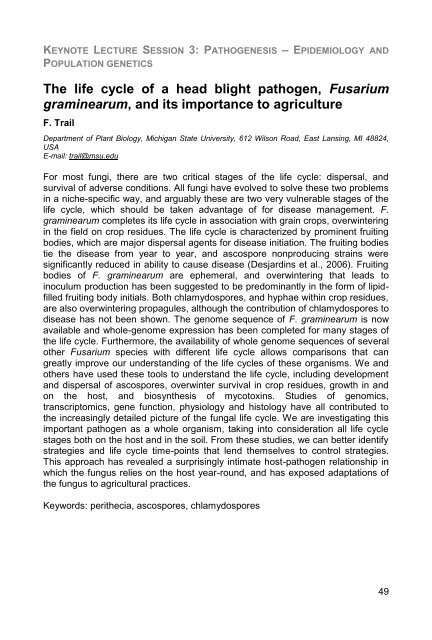EFS12- Book of abstracts - Contact
EFS12- Book of abstracts - Contact
EFS12- Book of abstracts - Contact
Create successful ePaper yourself
Turn your PDF publications into a flip-book with our unique Google optimized e-Paper software.
KEYNOTE LECTURE SESSION 3: PATHOGENESIS – EPIDEMIOLOGY AND<br />
POPULATION GENETICS<br />
The life cycle <strong>of</strong> a head blight pathogen, Fusarium<br />
graminearum, and its importance to agriculture<br />
F. Trail<br />
Department <strong>of</strong> Plant Biology, Michigan State University, 612 Wilson Road, East Lansing, MI 48824,<br />
USA<br />
E-mail: trail@msu.edu<br />
For most fungi, there are two critical stages <strong>of</strong> the life cycle: dispersal, and<br />
survival <strong>of</strong> adverse conditions. All fungi have evolved to solve these two problems<br />
in a niche-specific way, and arguably these are two very vulnerable stages <strong>of</strong> the<br />
life cycle, which should be taken advantage <strong>of</strong> for disease management. F.<br />
graminearum completes its life cycle in association with grain crops, overwintering<br />
in the field on crop residues. The life cycle is characterized by prominent fruiting<br />
bodies, which are major dispersal agents for disease initiation. The fruiting bodies<br />
tie the disease from year to year, and ascospore nonproducing strains were<br />
significantly reduced in ability to cause disease (Desjardins et al., 2006). Fruiting<br />
bodies <strong>of</strong> F. graminearum are ephemeral, and overwintering that leads to<br />
inoculum production has been suggested to be predominantly in the form <strong>of</strong> lipidfilled<br />
fruiting body initials. Both chlamydospores, and hyphae within crop residues,<br />
are also overwintering propagules, although the contribution <strong>of</strong> chlamydospores to<br />
disease has not been shown. The genome sequence <strong>of</strong> F. graminearum is now<br />
available and whole-genome expression has been completed for many stages <strong>of</strong><br />
the life cycle. Furthermore, the availability <strong>of</strong> whole genome sequences <strong>of</strong> several<br />
other Fusarium species with different life cycle allows comparisons that can<br />
greatly improve our understanding <strong>of</strong> the life cycles <strong>of</strong> these organisms. We and<br />
others have used these tools to understand the life cycle, including development<br />
and dispersal <strong>of</strong> ascospores, overwinter survival in crop residues, growth in and<br />
on the host, and biosynthesis <strong>of</strong> mycotoxins. Studies <strong>of</strong> genomics,<br />
transcriptomics, gene function, physiology and histology have all contributed to<br />
the increasingly detailed picture <strong>of</strong> the fungal life cycle. We are investigating this<br />
important pathogen as a whole organism, taking into consideration all life cycle<br />
stages both on the host and in the soil. From these studies, we can better identify<br />
strategies and life cycle time-points that lend themselves to control strategies.<br />
This approach has revealed a surprisingly intimate host-pathogen relationship in<br />
which the fungus relies on the host year-round, and has exposed adaptations <strong>of</strong><br />
the fungus to agricultural practices.<br />
Keywords: perithecia, ascospores, chlamydospores<br />
49
















![Présentation CRB-anim [Mode de compatibilité] - Inra](https://img.yumpu.com/17418636/1/190x135/presentation-crb-anim-mode-de-compatibilite-inra.jpg?quality=85)